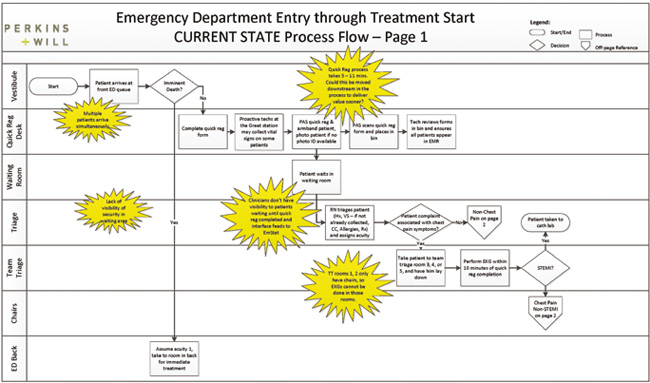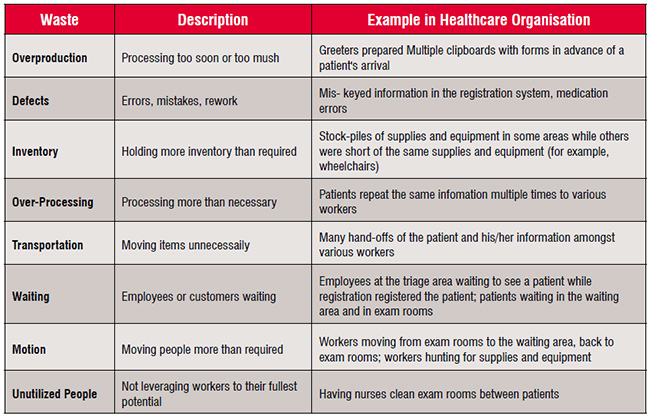A lean design process incorporates overlapping phases of the architectural process, resulting in designs that are developed quicker, more operationally efficient and with the elimination of waste.
Healthcare organisations are currently facing major challenges, including declining reimbursements, competing on patient wait times and satisfaction, and complying with time-sensitive care standards for high quality care. When designing healthcare facilities, it is important to consider more than architecture and construction. Taking a comprehensive view of operations includes considering the impact of four components on the overall system: people, processes, technology, and place. Taking these into consideration, healthcare organisations can achieve results in the three key aspects of their business: quality, efficiency, and experience. One way to achieve these results is through the use of Lean.
Lean, as a methodology for achieving efficiency, has gained popularity in healthcare in recent years. Lean can be a confusing term, particularly when taking concepts developed for the manufacturing industry and applying them to businesses that deliver services. The main focus of Lean is to drive value for the end customer, through the elimination of waste in the processes used to produce a product or service. With this broad goal, it is possible to imagine the countless opportunities to use Lean to improve processes, including in design.

The first step in Lean design is to identify the organisation's commitment to Lean methodologies. Organisations often look to leverage the opportunity of a new facility to rethink how business is done. There is no one-size-fits-all approach to improving efficiency or achieving better operational results. The organisation's culture and goals are key variables. Determining where the organisation falls on the scale below will help to define a process and design solution that matches the organisation's needs.
The next step is to identify the nature of the organisation's interest in Lean design. Lean can have many connotations in healthcare design. Most often, the healthcare organisation's interest lies within these categories:

When an organisation's interest is in the design of a Lean facility, it is prudent to perform a current state assessment. The purpose of the assessment is to understand the project goals and justification before beginning design. Instead of asking what the organisation wants, seek to understand what the organisation is trying to accomplish, in terms of results. This perspective transforms the context of discussions. Instead of discussions about a list of spaces to be included in the design, the discussion focuses on goals and measurable parameters for the design. When the discussions focus on the goals and results the organisation is attempting to achieve, designers may identify opportunities for the organisation to defer capital investments by enhancing the efficiency of existing spaces. The current state assessment ensures that the designer's solution is right-sized to the organisation's needs.
In the case of an organisation interested in Lean design processes, the designer's organisation must apply Lean to the architectural process. The architectural process is generally linear, with each phase unable to start before the previous phase is completed. Exacerbating the linear structure of the architectural process is the invalidation of the previous phase of a project during subsequent phases. A lean design process incorporates overlapping phases of the architectural process, resulting in a speedy design process, as well as better utilisation of the organisation's staff time. Organisation staff members attend fewer meetings, answer questions only once, and receive a building design much faster than with the linear process.
Lean operating processes is the third category of a Lean design request. Lean operating processes can be achieved through incorporating key Lean principles into design, such as flexibility. Another way to assist a healthcare organisation with achieving lean operating processes is by spanning the operational planning phase throughout the entire architectural process. Instead of having operational planning as one component in a linear architectural process, use operational planning as the 'glue' to provide continuity from phase to phase. This ensures that designs are driven by operations and the facility supports the functions that must take place within the facility.
When discussing the use of Lean in healthcare facility design, all three of the categories of application must be considered. There are many tools within the Lean toolbox, and the application of the tools to facility design can vary widely. There are several Lean tools that are useful in healthcare facility design.
Lean focuses on increasing the value delivered to the customer. The first step is to define the customer. In healthcare, the customer is often the patient, but may also be the physician, patient's family, or another healthcare organisation. After identifying the customer for a specific process, the value delivered to that customer is measured. Value stream maps analyse a process from the customer's perspective and demonstrate the value delivered at each step of the process. Key components of a value stream map include:

In most cases, these maps identify over half of the process as non-value added. When examining a process this way, one can quickly identify ways to make the process more efficient, and how to cut out unnecessary steps. The value stream map also serves as a visual method to convey the steps of a process. This is a very effective way to demonstrate understanding of a process. Another benefit of using value stream mapping is that the architect then has a map for how patients will flow through the space, which makes it easier to place the components in the space.
Value stream mapping was utilised to streamline the patient flow in an outpatient clinic. Leadership of the clinic sought to retain more patients in care. One key issue identified in the current care process was the 185 minute turn-around-time was more time than patients were willing to stay at the clinic. Many patients were leaving before seeing the doctor, or simply not scheduling appointments to be seen in the clinic. To identify how to reduce the turn-around-time, the team created a value stream map and presented it to the leadership.
Some of the changes that were identified to improve the process included:
Making just these three changes would result in cutting 67 minutes or 37 per cent from the process. With shorter turn-around-times, capacity is increased, without adding any exam rooms.

Process mapping is another visual way to understand a process. A process map is similar to a value stream map in that it conveys the steps of a process. However, a process map does not necessarily convey value nor does it view steps from customer's perspective. A process map can convey processes as simple as making a sandwich or as complex as patient flow through an entire facility. There is one main component of a process map: the steps of the process.
The figure below is a sample of a process map. Note how each step has a description and is connected to other steps within the series.
Process maps are useful in multi-disciplinary user group meetings, as the maps show how an action by one person triggers an action by the next person or department. In many cases, users are not aware how their work is related to the work of other departments. The exercise of developing a process map often leads to measurable improvements in the process, just by enhancing awareness of personnel conducting the steps in the process. The process map has similar benefits as the value stream map, including visually demonstrating the steps of a process, demonstrating an understanding of the process, and identifying how work is accomplished (and where it is accomplished).
Process mapping was utilised to explore the architectural process. A team of architects and an industrial engineer outlined the traditional architectural process and the tasks that happen in each phase of the process. The team wrote each task on a sticky note, and put it on a board, with each combination of sticky note color and marker color indicating a phase.
In redesigning the process, the team laid out three foam core boards on the table, and detailed each week in the architectural process across the top. Then, the team began pulling the sticky notes of tasks from the traditional architectural process and placing them on the weeks when they could happen in the new process. The team kept in mind the common issues with the traditional architectural process, and worked to mitigate those issues by integrating the tasks where possible. The traditional six phases of the architectural process were ignored, and instead, the team thought about what tasks could be done at the same time.
The new process shortened the amount of time needed to complete the architectural tasks by 12 weeks, and incorporated the client's operations, or planning into the process. Additionally, fewer meetings would be needed with the client, as the team would be integrated into meetings together.
In the traditional architectural process, there is lots of rework, as each phase has a kick-off and meetings that end up invalidating some of the work completed in the previous phase. Since the phases were designed to no longer take place in sequence, and instead were completed together and simultaneously, there was less rework and duplication of efforts. The new process should have fewer changes to the design late in the process, providing for more accurate budgeting as well. Overall, the team estimated the new process would save US$90,000 to US$120,000 per project, and cut 12 weeks from the design process.
Another key concept in Lean is the elimination of waste. Waste is any action that the customer would not be willing to pay for. There are eight types of waste in processes:


By identifying these wastes in processes, the processes can be modified to eliminate waste. Through this exercise, costs are reduced, quality is improved, and worker engagement is encouraged. This can be applied to both the healthcare organisation as well as the designer's work.
Waste elimination was utilised at a large community hospital with over 100,000 emergency visits annually. The hospital was challenged with reducing their patient waiting times, and a process analysis was conducted to understand the relationships between current operational practices, patient volumes, and flow of patients through the different areas of the emergency department.
The team utilised several methods to understand the operations of the emergency department, assess the primary causes of the challenges, and analyse several options to solve the challenges. The team utilised observational study, process mapping, data analysis and operational modeling to study the problem.
The Fast Track area of the emergency department, with the shortest turn-around-time for patients, was targeted for improvement. The team explored opportunities to serve more patients in the Fast Track, to achieve the following desired results:
Free upspace in the other areas of the emergency department, creating new capacity without any construction. Reduction in total patient turn-around-times for the emergency department, and Improvement in patient and staff satisfaction.
The analysis concluded that a shift in patient visits from care in the main and children's emergency to the fast track area would achieve the desired results. To make this change, the emergency department would need to add 16 more patient care spaces in fast track, and reduce the patient care spaces in the main emergency department by 22. The team identified opportunities that would improve operations and flow with minimal construction costs.
The main focus of Lean is to drive value for the end customer, through the elimination of waste in the processes used to produce a product or service for the customer. Some of the Lean tools that are very useful in application to healthcare design include value stream mapping, process mapping, and waste elimination. Lean methods applied to the design process result in designs that are developed faster and are more operationally efficient.